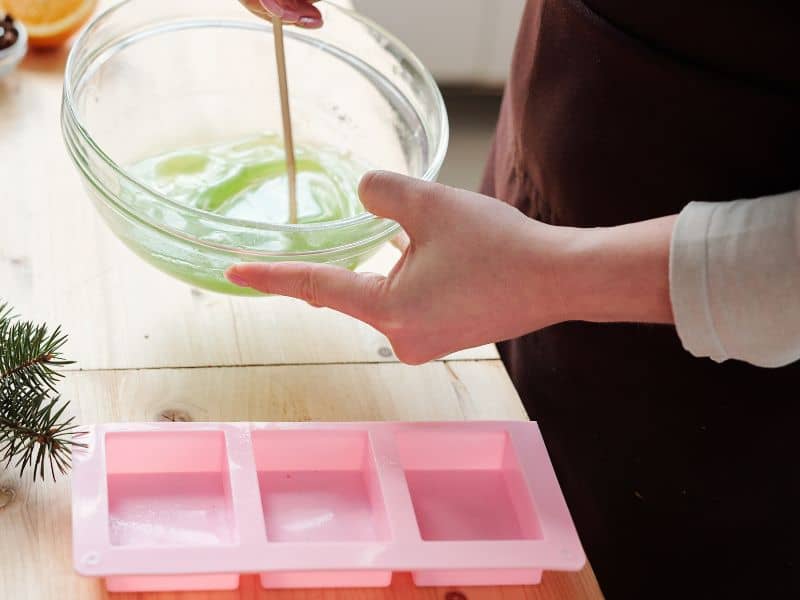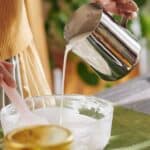A common challenge that soap makers face is their soap hardening too quickly, making it difficult to pour and design the final product. In this article, we’ll explore the reasons behind rapid soap hardening, and what can be done about it.
Melt and pour soap can harden quickly due to underheating and not maintaining an adequate temperature while adding other ingredients. Additionally, the soap base characteristics, humidity, and climate factors can all affect how quickly it hardens.
You can overcome the challenge of quick hardening MP soap if you practice proper melting techniques and monitor the temperature of your soap base. Choosing the right soap base for your project and understanding its properties can help you anticipate and adjust for hardening issues.
It is also important to maintain the temperature of the room you are working in. If it is too cool, your work environment can also make the soap base prematurely cool.
Following these guidelines can help ensure a smooth soap-making experience and you can create beautiful, high-quality soaps that meet your desired outcome. Let’s take a closer look at some other soap base hardening issues below.
Reasons for Quick Soap Hardening
Temperature mishandling
Improper temperature management can cause melt and pour soap to harden too quickly. A lot of MP soaps have a temperature of around 145°F (63°C) to pour the soap, however, if you are adding ingredients that temperature can quickly drop below 145°F (63°C).
Underheating results in a thicker consistency, which can harden faster.
If you are adding room temperature ingredients to your melt and pour soap base try heating above 145°F (63°C) somewhere in the range of 160°F (71°C).
Use some trial and error on test pours until you hit the perfect temperature.
Soap base variations
Soap bases have distinct melting points and hardening times. Glycerin-rich bases tend to harden faster than others due to their higher water content.
Oil-based soaps, such as shea butter or olive oil bases, can also harden quickly. Understanding your soap base’s properties allows you to anticipate and adjust for potential rapid hardening.
Humidity and climate impact
High humidity and temperature fluctuations can cause soap to harden rapidly. Humid air may introduce condensation into the soap base, accelerating the hardening process.
Maintaining a work environment with stable temperatures between 68°F to 72°F (20°C to 22°C) and low humidity can mitigate this issue.
Troubleshooting Quick Hardening
Reheating and remixing
If your soap hardens too quickly, gently reheat it in 10-15 second intervals using a microwave or use a double boiler, maintaining a temperature of at least 145°F (63°C).
Stir the soap base occasionally to ensure even heating. Once it reaches the desired consistency, pour it back into the mold.
You can even wrap a towel around the bowl to help maintain the temperature until you are ready to pour the ingredients.
Alternatively, an induction cooktop (hotplate) or presto pot are both great ways to maintain temperature when making soap or candles.
Mold selection
Choosing the right mold can make a difference. Silicone molds are great at retaining heat, giving you more time to work with the soap.
Plastic or wooden molds can cool the soap faster. Experimenting with different mold materials can help you find the best one for your needs.
Patience and practice
Melt and pour soap making is a fun and creative process that requires practice. If your soap hardens too quickly, don’t get discouraged.
Instead, continue experimenting with different techniques, bases, and additives to perfect your craft.
With time and patience, you’ll be able to create beautiful, unique soaps that harden at just the right pace.
Proper Melting Techniques
Microwave method
The microwave method is a quick and convenient way to melt soap. Cut the soap base into small, evenly-sized cubes, and place them in a microwave-safe container.
Heat the soap in 30-second intervals, stirring gently after each interval to ensure even melting. Be cautious not to overheat, as this can cause the soap to boil or burn, impacting the final product’s quality.
Double boiler method
The double boiler method offers more control over the melting process. Fill the bottom pan of a double boiler with water and heat it to a gentle simmer. Place the soap base cubes in the top pan, allowing them to melt slowly.
Stir the soap occasionally to promote even melting and prevent overheating. This method ensures a consistent temperature, reducing the risk of rapid hardening.
Monitoring temperature
Using a kitchen thermometer, monitor the soap base’s temperature throughout the melting process. Aim for a temperature of at least 145°F (63°C), depending on the soap base.
Maintaining the appropriate temperature will help prevent quick hardening and create a smooth, easy-to-work-with consistency.
Choosing the Right Soap Base
Glycerin-rich bases
Glycerin-rich bases are popular for their transparency and moisturizing properties. However, they can harden quickly due to their high water content.
If you’re working with glycerin-rich bases, make sure to monitor the temperature closely and work efficiently to avoid rapid hardening.
Shea butter and cocoa butter bases
Shea butter and cocoa butter soap bases are rich in natural oils, making them highly moisturizing. These bases may harden quickly, so it’s essential to follow proper melting techniques and monitor the temperature to achieve the desired consistency.
Additionally, consider using a heat-retaining mold to extend the soap’s workable time.
Olive oil-based soaps
Olive oil-based soaps are known for their gentle, nourishing properties. They can harden faster than other bases due to their oil content.
To work with olive oil-based soaps, maintain the recommended temperature range and consider incorporating additives that enhance fluidity, such as liquid glycerin or other oil-based additives.
Controlling Humidity and Climate
Using a dehumidifier
High humidity can accelerate soap hardening. To control humidity levels, consider using a dehumidifier in your work area.
This device will help maintain optimal conditions, reducing the likelihood of rapid hardening and improving the overall soap-making experience.
Proper storage
Proper storage of soap bases and finished products is essential to prevent unwanted moisture absorption. Store soap bases in airtight containers, and keep them in a cool, dry place.
Finished soaps should be wrapped in wax paper or plastic wrap, protecting them from humidity and preserving their quality.
Adjusting work environment
Creating a stable work environment is crucial for successful soap making. Maintain a consistent room temperature between 68°F to 72°F (20°C to 22°C) and minimize temperature fluctuations.
If possible, avoid working near drafts, open windows, or air vents, as these can contribute to uneven cooling and rapid hardening.
Enhancing Soap Fluidity
Adding liquid soap additives
To improve soap fluidity and slow down hardening, consider adding liquid soap additives such as glycerin or a small amount of carrier oil (e.g., almond oil, coconut oil).
These additives can help maintain a workable consistency, giving you more time to pour and design your soap.
Reducing solid additives
Excessive use of solid additives, such as colorants, fragrances, or exfoliants, can cause soap to harden more quickly.
To counteract this, reduce the amount of solid additives or opt for liquid alternatives. For example, use liquid colorants and essential oils instead of solid pigments and fragrance cubes.
Using stirring techniques
Proper stirring techniques can help maintain fluidity and prevent soap from hardening too quickly. Gently stir the soap base throughout the melting process to ensure even heating.
Once additives are incorporated, stir slowly and carefully to avoid introducing air bubbles, which can cause the soap to cool and harden faster.
Frequently Asked Questions
Both methods have their benefits. The microwave method is quick and convenient, while the double boiler method offers more control over the melting process.
Use a dehumidifier to maintain optimal humidity levels, and store soap bases and finished products in airtight containers in a cool, dry place.
Yes, additives like glycerin or a small amount of carrier oil can help maintain a workable consistency, giving you more time to pour and design your soap.
Some molds, like silicone, are better at retaining heat, giving you more time to work with your soap before it hardens.
Yes, proper stirring techniques help maintain fluidity and prevent soap from hardening too quickly. Gently stir the soap base throughout the melting process and avoid introducing air bubbles.
Practice patience and continue experimenting with different techniques, bases, and additives. With time and experience, you’ll be able to create beautiful soaps that harden at the desired pace.
Conclusion
In conclusion, melt and pour soap making is an enjoyable and creative activity that allows you to craft personalized soaps with ease. However, sometimes melt and pour soap can harden too quickly due to issues such as temperature management, soap base characteristics, and even the temperature inside your home.
Following proper melting techniques, choosing the right soap base, and controlling your work environment will ensure a smoother soap-making experience. With patience, practice, and the knowledge shared in this article, you can overcome the challenge of quick hardening and create beautiful, high-quality soaps that you’ll be proud to share and enjoy.






